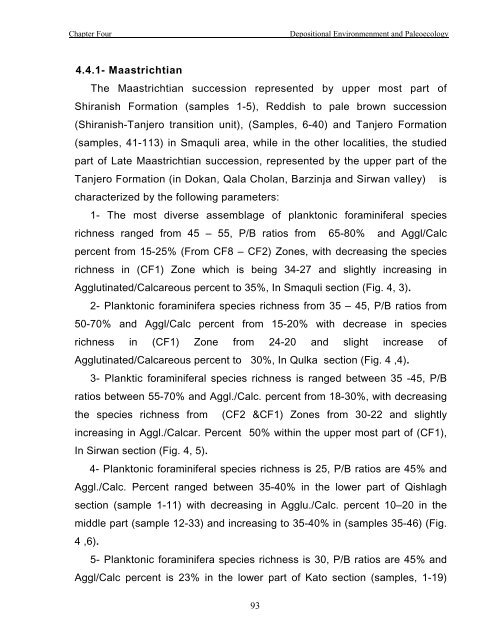biostratigraphy and paleoecology of cretaceous/tertiary boundary in ...
biostratigraphy and paleoecology of cretaceous/tertiary boundary in ...
biostratigraphy and paleoecology of cretaceous/tertiary boundary in ...
You also want an ePaper? Increase the reach of your titles
YUMPU automatically turns print PDFs into web optimized ePapers that Google loves.
Chapter Four<br />
Depositional Environmenment <strong>and</strong> Paleoecology<br />
4.4.1- Maastrichtian<br />
The Maastrichtian succession represented by upper most part <strong>of</strong><br />
Shiranish Formation (samples 1-5), Reddish to pale brown succession<br />
(Shiranish-Tanjero transition unit), (Samples, 6-40) <strong>and</strong> Tanjero Formation<br />
(samples, 41-113) <strong>in</strong> Smaquli area, while <strong>in</strong> the other localities, the studied<br />
part <strong>of</strong> Late Maastrichtian succession, represented by the upper part <strong>of</strong> the<br />
Tanjero Formation (<strong>in</strong> Dokan, Qala Cholan, Barz<strong>in</strong>ja <strong>and</strong> Sirwan valley) is<br />
characterized by the follow<strong>in</strong>g parameters:<br />
1- The most diverse assemblage <strong>of</strong> planktonic foram<strong>in</strong>iferal species<br />
richness ranged from 45 – 55, P/B ratios from 65-80% <strong>and</strong> Aggl/Calc<br />
percent from 15-25% (From CF8 – CF2) Zones, with decreas<strong>in</strong>g the species<br />
richness <strong>in</strong> (CF1) Zone which is be<strong>in</strong>g 34-27 <strong>and</strong> slightly <strong>in</strong>creas<strong>in</strong>g <strong>in</strong><br />
Agglut<strong>in</strong>ated/Calcareous percent to 35%, In Smaquli section (Fig. 4, 3).<br />
2- Planktonic foram<strong>in</strong>ifera species richness from 35 – 45, P/B ratios from<br />
50-70% <strong>and</strong> Aggl/Calc percent from 15-20% with decrease <strong>in</strong> species<br />
richness <strong>in</strong> (CF1) Zone from 24-20 <strong>and</strong> slight <strong>in</strong>crease <strong>of</strong><br />
Agglut<strong>in</strong>ated/Calcareous percent to 30%, In Qulka section (Fig. 4 ,4).<br />
3- Planktic foram<strong>in</strong>iferal species richness is ranged between 35 -45, P/B<br />
ratios between 55-70% <strong>and</strong> Aggl./Calc. percent from 18-30%, with decreas<strong>in</strong>g<br />
the species richness from (CF2 &CF1) Zones from 30-22 <strong>and</strong> slightly<br />
<strong>in</strong>creas<strong>in</strong>g <strong>in</strong> Aggl./Calcar. Percent 50% with<strong>in</strong> the upper most part <strong>of</strong> (CF1),<br />
In Sirwan section (Fig. 4, 5).<br />
4- Planktonic foram<strong>in</strong>iferal species richness is 25, P/B ratios are 45% <strong>and</strong><br />
Aggl./Calc. Percent ranged between 35-40% <strong>in</strong> the lower part <strong>of</strong> Qishlagh<br />
section (sample 1-11) with decreas<strong>in</strong>g <strong>in</strong> Agglu./Calc. percent 10–20 <strong>in</strong> the<br />
middle part (sample 12-33) <strong>and</strong> <strong>in</strong>creas<strong>in</strong>g to 35-40% <strong>in</strong> (samples 35-46) (Fig.<br />
4 ,6).<br />
5- Planktonic foram<strong>in</strong>ifera species richness is 30, P/B ratios are 45% <strong>and</strong><br />
Aggl/Calc percent is 23% <strong>in</strong> the lower part <strong>of</strong> Kato section (samples, 1-19)<br />
93

















